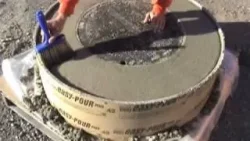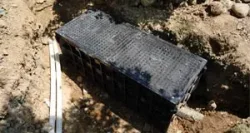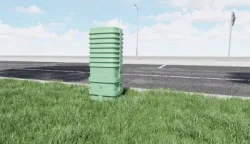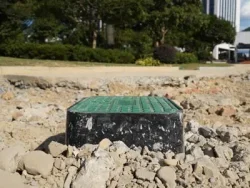2022-05-09
What are Fiber Optic
An optic cable consists of a fiber core, plastic cladding, and steel wire that prevent fiber core twists or fractures. The cable routine is one basic work an optic technician will do.
Single-core fiber and Multimode core fiber
Single-core fiber has a small core diameter with a single path for long-distance communications.
Multimode core fiber has big size fiber core with multiple paths for data telecommunication, cloud service, storage, and download.
Fiber is a material stronger than steel, will not rust like copper, and can work for hundred of years, but fiber splitter and hubs that serve us can easily be blocked by water, grits, grime, and even destroyed by rotten. A handhole is an underground protection vault that allows easy access to fiber optic cables, or telecommunication wire for splicing or repairs.
Why People Rely on Fiber Optic Bandwidth
People need to deliver pictures, voice, video, and even data that drive robots. Most data from users in a local area network pass through these hubs to connect to other networks. For networks and data centers on the other networks. Networks and data centers on the other side of the world, this journey will likely traverse the seabed. The light signals transfer at a speed faster than 100,000 miles per second, and they carry more than 95% of the international data.
Perhaps we use analog codes and transmit them like the light passing water, we take an analog signal and cut them into sections consisting of 0 and 1 and approximate the wave’s amplitude as best as we can. The optic signal does not decay after being transported for thousands of miles.
The analog signals will not decay as digital signals in long-distance transfer. A Digital signal of 4.5v might become an 0.5-ampere signal after a 2-meter copper cable transfer because electrical power dissipates in the metals. And the 4.5v digital signal will disappear after hundreds of meters of cables because of energy exhaustion.
What Does a Fiber Optic Contractor Do?
As a fiber optic contractor, you install, maintain, and repair fiber optic cables. Your responsibilities may require you to travel within a local geographic area, to service different sites. Your duties include accessing fiber optics for inspection or repair, whether they are buried or suspended, measuring signal strength, inspecting system performance, and identifying defects. You implement cable placement during construction, splice cables for better service, oversee the design of projects, and communicate with clients to ensure the system meets their needs. A fiber optic contractor works from design to the final product.

The Contractor do and not do list
Design
One should be able to rely on the contractors to not only do the installation but to assist in the design of the network and help choose components and vendors. Once the contractor has the assignment, they should be able to help the customer choose the right kinds of fibers, cables, connectors and hardware for the installation. The contractor should know which components meet industry standards that will ensure interoperability and what are the state of the art components to facilitate future expandability.
Installation
The actual installation process can involve more than just putting in cable, terminating and testing it. If the contractor is knowledgeable and experienced, the user may ask the contractor to purchase, receive, inspect and bring components to the work site also, which can be another good source of revenue for the contractor. Having full control of the materials process can also make life easier for the contractor, as they have a better chance to keep on schedule rather than depending on a customer who has many other priorities. Plus, they may have the latitude to choose components they are more familiar with, facilitating the actual installation process.
Evaluating Subcontractors
How do you evaluate subcontractors? The top of the list of requirements is experienced in similar jobs backed by great references. Are their designers, managers and installers trained and certified? How much personnel turnover do they have? What's their plan for on-the-job training (OJT) for new recruits? Are they fully equipped for the job? What other jobs are they qualified for? Electrical construction and fiber optics are often done by the same contractor and may yield a more efficient construction when electrical services are required in communications facilities.
Government Bid ooptic projects are hard to get. The contractor must be experienced in fiber optic cable plant installations and should be able to provide references for similar work. That just covers the company. Each worker that will be in a crew installing the network needs to be trained and should be certified as a fiber technician such as a FOA CFOT, since it is the individual worker, not the company, that will be doing the actual installation work. New workers or apprentices should have an experienced supervisor and or mentor under whom they are working and learning the skills of a fiber optic installer so their work is properly done also.
Beware of subcontractors. You may choose a competent contractor but they may subcontract the actual work to, well, anyone, especially lower cost contractors. We have seen subcontractors do serious damage, landscapers hired to do trenching cutting other cables or subcontractors disrupting utilities like water mains by directional boring. We've seen incredibly messy aerial installations and installers destroying cable by pulling it improperly. Not just how cheap they will do it. We've seen jobs go to the lowest bidder where the contractor installed thousands of splices and connectors improperly, submitted erroneous test data, got paid and disappeared leaving the network owner holding the bag. We suggest every contract has a clause that subcontractors must be trained, certified and approved by the customer.
Details, Details, Details
The final four requirements from the contractor, testing, troubleshooting, documentation and restoration, need to be discussed before the project ever begins. When it comes to testing, every fiber optic project requires insertion loss testing of every link with a light source and power meter or optical loss test set according to industry standards. Some projects, like long outside plant links with splices, may also require OTDR testing. The contractor and customer must agree that testing includes troubleshooting problems – and fixing them – as well as documenting test results for every link.
Likewise, for the contractor, documentation must begin before the project starts so the scope of work is known to everyone and end only when the final test data is entered. Copies of the documentation, along with excess components leftover from the installation, must be presented to the customer to facilitate future network restoration, should it be required.
The Contract
The contract must include detailed requirements for the project, spelling out exactly what is to be installed, including acceptable test results, and what documentation must be provided. All this should be discussed between the customer and the contractor and agreed to in writing. They are not irrelevant details, as they are important to ensure the customer gets what they expect and the contractor knows what is expected of them when designing the network, estimating costs, doing the actual installation and providing proof of performance in order to show the work is completed and payment should be made.
Supervision
Once the contractor is chosen and the contract signed, the responsibiliity of the customer has not ended. The project still requires supervision, regular progress reports and meetings because few projects are completed without problems. Don't wait until it's too late; stay informed.
Are We Finished Yet?
The customer wants their operating network and the contractor wants to get paid and move on to the next project, but when is the network finished.
Fiber Optic Infrastructure
While the infrastructure on land and underwater is vulnerable to the occasional curious creatures. In some circumstances, though, satellites are needed to deliver the internet. Very remote areas don’t have the population density to make an economic case for cabling, so satellites are the preferred option. For security reasons, many governments and their military also rely on satellites.
In the US, there are still millions of people lacking access to the internet with high-speed bandwidth. Reasons include the lack of data centers, last-mile infrastructure for new residential areas, and unaffordable costs for rapidly increasing immigration, or homelessness. There are vast demands for highspeed bandwidth in US
People think that the internet is in the cloud, people think of wireless things going through the air, but the reality is that 98% of traffic goes through the fiber optic cables. People need more bandwidth, telecom service providers can not scale using the existing cables because they do not have enough capacity. The curie is a subsea optic cable project that starts from California and reaches Chile. Brazil announces submarine optical fiber cable project with Europe
Jinmeng Telecom Handhole
Jinmeng Telecom Handhole has proven to be a perfect solution for communications service providers to maintain and expand their optic networks. Telecom handholes protect fiber distribution hubs & fiber splitter, and optic cable, prevent the entrance of grits and leaves, as well as water that will contaminate the fiber optics. Consist of SMC composites polymer resin, Custom Colors, size, tailored Sign and message, rust-free, chemical resistant, injury free maintenance by one technician, and allows temporary traffic of vehicle passes.
Fiber Optic History
Although it is a creation in the late 1960s, the internet was only widely adopted in 1989 after the invention of the world wide web, revolutionizing the way we communicate. When you email, google, SNS, or post a video online, that data is sent through cables or more commonly radio waves to a router or cell phone tower. From there, these signals are sent through a series of fiber optic cables in the form of pulse of light to an internet exchange, which acts as a sorting office.
Open Access networks provide consumers with multiple choices for broadband service, as multiple Internet Service Providers share the same broadband infrastructure. Jinmeng Telecom Handhole has proven to be a perfect solution for communications service providers to maintain and expand their optic networks. Telecom handholes protect fiber distribution hubs & fiber splitter, and optic cable, prevent the entrance of grits and leaves, as well as water that will contaminate the fiber optics. Consist of SMC composites polymer resin, Custom Colors, size, tailored Sign and message, rust-free, chemical resistant, injury-free maintenance by one technician, and allows temporary traffic of vehicle passes.
How to Select The Right Irrigation Valve Box for Your Business




